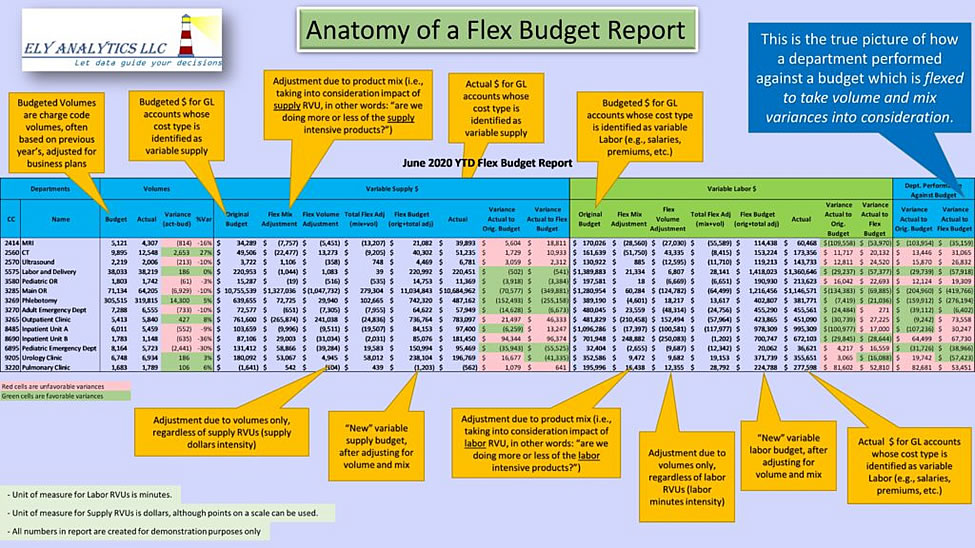I have posted before about hospital flex budget reports. In this article, I will explore its elements and how to interpret it. Below is a self-explanatory picture that shows the important components of a typical flex budget report.

Click on image for PDF
What does a Flex report tell us? The two right most columns are the crux of the Flex report. One column shows how a department performed against a static budget (developed months earlier with certain assumptions in mind), and the other column shows how a department performed against a newly "flexed" budget, that took product volume and mix into consideration.
This latter part is important because volume and mix are associated with revenue. Given a constant mix, the higher the volume the more the revenue (and vice versa), and given a constant volume, the higher the mix (i.e., more resource intensive products) the higher the revenue (and vice versa).
You can be under budget (per your static budget variance report), yet over budget per Flex. Look at the Outpatient Clinic (3265) and Inpatient Unit A (8485) as examples. Both had favorable performance per the budget variance report, yet, after taking the type of charge codes billed (i.e., mix adjustment) into consideration, Flex found the two departments to be over budget.
Looking a little more closely at each one, the Outpatient Clinic had more actual volume than budgeted, but they did more of the less intensive products than budgeted. So, although they came under the static budget, it was not enough to compensate for the “light load” they had. On the other hand, Inpatient Unit A had lower than budgeted volumes, and they did come under static budget, but they should've come in more under budget, due to the lighter load.
Although this report looks busy, you can re-arrange it to suit your audience. You can add percentage columns for all variance columns (to enhance the information) or eliminate some columns (like volume and mix adjustments) if you only want to display the net flex adjustment. In my experience, executives like to see reports with fewer columns, while Finance and the leaderships of operational areas like to see the details.
Flex reports are not meant to be snap shots. Carefully examining the report and tracking it over time helps uncover issues that may otherwise be difficult to detect. This report is often the first stage in a budget variance investigation. Keep in mind that the numbers associated with each department are derived from individually costed charge codes, which is where your second stage of investigation lies.
Issues that can be revealed in an investigation may include:
- Missing charges
- Insufficient charges
- Lack of labor hour cross-charging, when appropriate (e.g., staff doing work in other departments, but costs remaining in home department)
- Lack of supply cost cross-charging, when appropriate (e.g., POs with wrong charging information, or staff "borrowing" expensive supplies from other departments)
- Missing or highly inaccurate RVUs
- Mismanagement of staff schedules (e.g., volumes dropping significantly, but continuing to staff at former levels)
Due to the complex nature of the calculations, and the many variables that can impact the results, it is important to recognize that flex reports are most accurate when looking at year-to-date (YTD) data. Comparing individual months to each other may show wild swings in the results, but tracking YTD performance usually shows more consistency, especially towards the end of the fiscal year.
Related to the point above, if a hospital introduces a new department (e.g., a new outpatient program), it may take several months before the flex results "settle". The reason is that, as often happens with new programs, it takes a while to iron out all the wrinkles associated with GL costs and billing.
As mentioned in earlier posts, you cannot do proper flex budget reporting without Activity Based Cost (ABC) accounting. Hospitals that use Ratio of Cost to Charge (RCC) cost accounting may not have all the granularity necessary to build a flex report.
The calculations that go into producing a flex report are very complex, but fortunately, they can be done outside of expensive Decision Support Systems.
Sahel Shwayhat, MBA, FACHE, Principal at ELY Analytics, is a Management Consultant with over 30 years of experience in Healthcare Operations and Data Analytics. A Lean Six Sigma Black Belt, Mr. Shwayhat has dual degrees in Electrical and Biomedical Engineering. He is also is fellow in the American College of Healthcare Executives. Mr. Shwayhat's career spans multiple roles, where he gained significant experience analyzing large data sets to uncover inefficiencies, identify outliers, and compare staff and equipment outputs. He is adept at performing location analytics to identify potential clients, focus resources, and capture a greater share of the market.
©Copyright - All Rights Reserved
DO NOT REPRODUCE WITHOUT WRITTEN PERMISSION BY AUTHOR.











